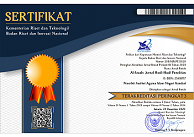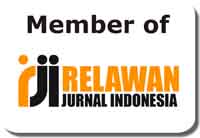Kekerasan Simbolik Dalam Tradisi Perkawinan Masyarakat Tolaki Sulawesi Tenggara
Abstract
The position of customary institutions in traditional societies has two faces; be a protector and solution for the community, but can also be a dominant and even compelling force. This study will examine the marriage traditions of the Tolaki community that move between apparent compromise and potential conflict. Indigenous marriages implicitly indicate a form of symbolic violence that constructs false compromise in Tolaki society as well as potential latent conflicts. Symbolic violence can be found in several forms, namely injustice in the opportunity to marry women from any group; and rejection of procedures and marriage procedures. This condition is caused by social differences in the community; there is no legitimacy of the crime and the same opportunities; differences in interests between various parties; and the dominance of the indigenous elite. However, the marriage practices of the Tolaki community bring change with the loosening of the system and the social structure of the Tolaki community which was originally "closed." This can open up equal opportunities for all segments of society to get a life partner so that a more egalitarian society can be created.
Keywords
Full Text:
PDFReferences
Appleby, R. Scott. The Ambivalence of The Sacred. New York: Carnegie Corporation, 2000.
Bourdieu, Piere. Dominansi Maskulin (Pent. Stephanus Aswar Herwinarko). Yogyakarta: Jalasutra, 2010.
Camara, Dom Helder. Spiral Kekerasan. Yogyakarta: Resist Book, 2005.
Canolly, Peter (Ed). Aneka Pendekatan Studi Agama. Yogyakarta: LkiS, 1999.
Coser, Lewis. The Function of Social Conflicts. London: Free Press of Glencoe, 1956.
Maskota Defli, “Contemporary Mentawai Recapitulates Anchestry: The Position of Women in Siberut Society”, Jurnal Humaniora, Vol. 25, No. 1 (Februari 2013): 14-24.
Dillistone, F.W. The Power of Symbols. Yogyakarta: Kanisius, 2002.
Foucault, Michel. Histoire De La Sexualite. Vol 1, La Volonte’ de savoir. Paris: Gallimard, 1976.
Giddens, Anthony. Teori Strukturasi untuk Analisis Sosial. Pasuruan: Pedati, 2003.
Hamdi, Saipul. “Tuan Guru, Otoritas, Politik Dan Reproduksi Kekerasan-Ritual Dalam Konflik Nahdlatul Wathan Di Lombok NTB”. Tt. Tp.
Haryatmoko. Etika Politik dan Kekuasaan. Jakarta: Kompas, 2003.
--------------. “Menyingkap Kepalsuan Budaya Penguasa”. BASIS. No. 11-12, (November-Desember, 2003).
Hefni, Moh. “Tradisi Mawlid Dan Kekuasaan Simbolik Kyai Di Madura”. Jurnal Nuansa, Vol 10, No. 2 (Juli-Desember, 2013): 314-334.
Mas’oed, Mohtar. Kritik Sosial dalam Wacana Pembangunan. Yogyakarta: UII Press, 1999.
Nur, Rosmala. “Nilai-Nilai Budaya Lokal dan Kekerasan terhadap Perempuan masa Hamil di Kabupaten Donggala, Sulawesi Tengah”, Jurnal Humaniora, Vol. 24, No. 1 (Februari 2012): 37-49.
Patria, Nezar & Andi Arief. Antonio Gramsci; Negara & Hegemoni. Yogyarakarta: Pustaka Pelajar, 2003.
Pruitt, Dean G & Jeffrey Z. Rubin. Teori Koflik Sosial. Yogyakarta: Pustaka Pelajar, 2004.
Rais, Muhammad. “Hegemoni Elit Dalam Ritus Agama Lokal: Studi Keberagamaan Masyarakat Bugis Bone Sulawesi Selatan”. Jurnal el-Harakah Vol. 12, No. 2 (2010): 99-119.
Riches, D, “The Phenomenon of Violence” Dalam The Anthropology of Violence, disunting oleh D. Riches, (Oxford: Blackwell, 1986).
Ritzer, George & Douglas J. Goodman. Teori Sosiologi Modern. Jakarta: Pernada Media, 2003.
Robertson, Ian. Sociology. Second Edtion. London: Worth Publishers, 1981.
Rozaki, Abdur. Social Origin dan Politik Kuasa Blater di Madura”. Kyoto Review of Southeast Asia, 12 Nov 2009, http:// kyotoreview.org/issue-11/the-social-origins-and-political-powerof-blaters-thugs-in-madura/, accessed 28 Oct 2018.
Salmi, Jamil. Violence and Democratic Society. Yogyakarta: Pilar Media, 2005.
Santoso, Thomas. Teori-Teori Kekerasan. Jakarta: Ghalia Indonesia, 2002.
Sarmin, “Ruang dan Kultur kekerasan Domestik; Pengalaman Perempuan Madura di Kemayoran baru Surabaya”, Jurnal Humaniora, Vol. 20, No. 1 (Februari 2008): 38-50.
Schroder, I.W dan B.E. Schmidt. 2001. “Introduction: Violence Imaginaries and Violence Practice. Dalam Anthropology of Violence and Conflict, disunting oleh I.W. Schmidt dan B.E. Schroder. London: Routledge, 2001.
Sihombing, Justin M. Kekerasan Terhadap Masyarakat Marginal. Yogyakarta: Narasi, 2005.
Suseno, Frans-Magnis. Melawan Kekerasan Tanpa Kekerasan. Yogyakarta: Pemeliharaan Kesehatan Remaja, 2002.
Tajima, Yuhki. 2004. Mobilizing for Violence: the Escalation and Limitation of Identity Conflicts. Jakarta: World Bank office.
Tarimana, Abdur Rauf. 1985. Kalo Sebagai Fokus Kebudayaan Tolaki. Disertasi. Jakarta: Universitas Indonesia.
Tim. Adat dan Upacara Perkawinan Daerah Sulawesi Tenggara. Jakarta: Proyek Penelitian dan Pencatatan Kebudayaan Daerah Sulawesi Tenggara, 1978/1979.
Triratnawati, Atik, “Pola Antenatal Care dan Health Seeking Behavior Ibu Hamil Suku Mbojo, Bima, Nusa Tenggara Barat”, Jurnal Mozaik Humaniora, Vol. 18, No. 1 9 Januari-Juni 2018): 33-49.
Yusuf, A.M. “Assituruseng: Hegemoni Budaya Dalam Praktik Politik dan Kekuasaan di Belawa”, ETNOSIA: JURNAL ETNOGRAFI INDONESIA, Vol. 2, No. 1, (Juni 2017): 74-94.
Website:
James, Susan. “Structural Violence: The invisible Violence in Our Community”. . Diakses 16 Mei 2018.
Muller, Ragnar. “Peace Education”.. Diakses 13 April 2018.
Narayana, Badri. “Itegration Without Conflict Possible?” Dalam Badri Pastimes. . Diakses 16 Agustus 2018.
Saughstad, Andreas. “Structural & The Autonomy of Morals”. Dalam GO Inside. . Diakses 18 Agustus 2018.
Winter, Deborah Du nann & Dana Leighton. “Structural Violence Introduction”. . Diakses 26 Juli 2018.
DOI: http://dx.doi.org/10.31332/ai.v13i2.1068
Copyright (c) 2018 Al-Izzah: Jurnal Hasil-Hasil Penelitian

This work is licensed under a Creative Commons Attribution-NonCommercial-ShareAlike 4.0 International License.










